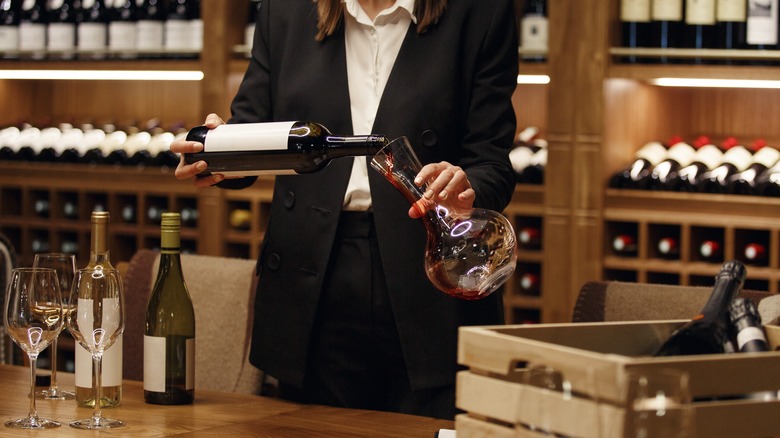Will Decanting Really Make Or Break You Next Glass Of Wine?
A wine decanter is a useful, though sometimes intimidating, tool that can perplex novice oenophiles — aka wine lovers. The truth is that almost all red wines (and even some whites) can benefit from the use of these specialized vino vessels. Decanting and allowing the wine to 'breathe' before serving elevates the drinking experience and enhances its quality.
For older wines, especially robust reds, decanting helps to separate sediment, which may have settled in the bottle — which, while harmless, can make for a visually unappealing glass. Pouring wine from its original bottle into the specially designed carafe also allows it to mingle with the air so that oxygen can work its magic. The wine's natural aromas are released and flavors develop; the wine 'opens up,' so to speak. Decanting also helps settle the tannins that can make a wine overly bitter or harsh. These fragile flavors and important structural elements of wine are one of the reasons you should never use soap to clean your wine decanter, lest you leave a sudsy residue.
While beneficial for most wine, decanting is not always an absolute necessity, and there are some occasions when a wine may taste great right out of the bottle. It's generally less common to subject white wines to this process, but complex, full-bodied white varieties (think Chardonnay or Chablis) can improve with a quick decant. Crisp, light-bodied whites are more delicate and may lose their zesty flavors if decanted, and sparkling wine can easily go flat.
Decanting red wine
As with many of the finer elements of drinking culture, there is some nuance and know-how when it comes to the art of decanting. For bottles that have been stored horizontally, sit them upright for at least 24 hours before decanting, so sediment may settle at the bottom and separate with ease while pouring. When transferring the wine to a decanter, it should be poured slowly, at an angle. Ensure you keep the bottom of the bottle low and leave some liquid behind to trap the cloudy sediment. This careful decanting method can also be used to filter broken cork pieces out of your wine.
For younger, recently bottled wines, aeration is the goal. Shock, or quick splash, decanting involves pouring the wine rapidly into the vessel to maximize oxygen mixing. To reap the full rewards of this method, prepare to exercise some patience. Light-bodied wines, like pinot noir or zinfandel, should rest for 20 to 30 minutes in the decanter — whereas full-bodied reds, like petite sirah, may take between one and two hours. For medium-bodied wines, like tempranillo, 20 minutes to an hour is recommended.
The benefits of air only go so far, and too much exposure will spoil a good wine. Drink or serve your decanted wine within a few hours of opening. Older wines will degrade faster than young ones, and any bottle that is more than 10 years old shouldn't be left open for more than 25 minutes before being consumed.
When to decant white wines
You may not always see white wine in a decanter, but there are some circumstances in which the technique can help bring out the best in a wine. In much the same way it can release the flavors of a newly bottled red, decanting can round out the profile of a 'tight' white wine. They aren't prone to the same type of sediment that affects red wines, but some whites have their own brand of debris, and some can even form tartrates (crystals sometimes called wine diamonds, which are formed from tartaric acid) that disrupt their clean appearance.
If you sense an unpleasant odor when you pop open your wine, decanting is key. The smell of rotten eggs or burnt rubber can indicate the buildup of hydrogen sulfide or carbon dioxide in a bottle that has gone without oxygen for a lengthy stretch of time. This is referred to as 'reduced' wine, and it can happen to reds as well. An easy 15-minute decanting session will release those unpleasant odors and allow the wine's natural aroma to shine through. When pressed for time, or if you don't have a decanter on hand, an aerating pour spout is the next best way to decant a wine.



